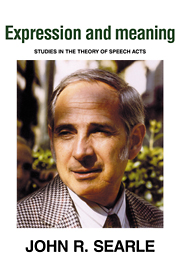Introduction
Published online by Cambridge University Press: 05 June 2012
Summary
These essays represent a continuation of a line of research begun in Speech Acts (Searle, 1969). Most of them were originally projected as chapters of a larger work in which discussions of some of the outstanding problems of speech act theory – for example, metaphor, fiction, indirect speech acts, and a classification of types of speech acts – were to have been embedded in a general theory of meaning, in which I hoped to show in what ways the philosophy of language was based on the philosophy of mind, and in particular how certain features of speech acts were based on the Intentionality of the mind. The original chapter on Intentionality however has now grown into a book length manuscript of its own, and when the Intentionalistic tail outgrew the linguistic dog it seemed a better idea to publish these studies as a separate volume. This book then is not intended as a collection of unrelated essays, and my main aim in this introduction is to say something about how they are related.
One of the most obvious questions in any philosophy of language is: how many ways of using language are there? Wittgenstein thought the question unanswerable by any finite list of categories. “But how many kinds of sentence are there? … There are countless [unzählige] kinds” (1953, para. 23).
- Type
- Chapter
- Information
- Expression and MeaningStudies in the Theory of Speech Acts, pp. vii - xiiPublisher: Cambridge University PressPrint publication year: 1979



